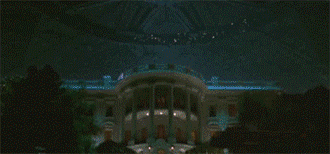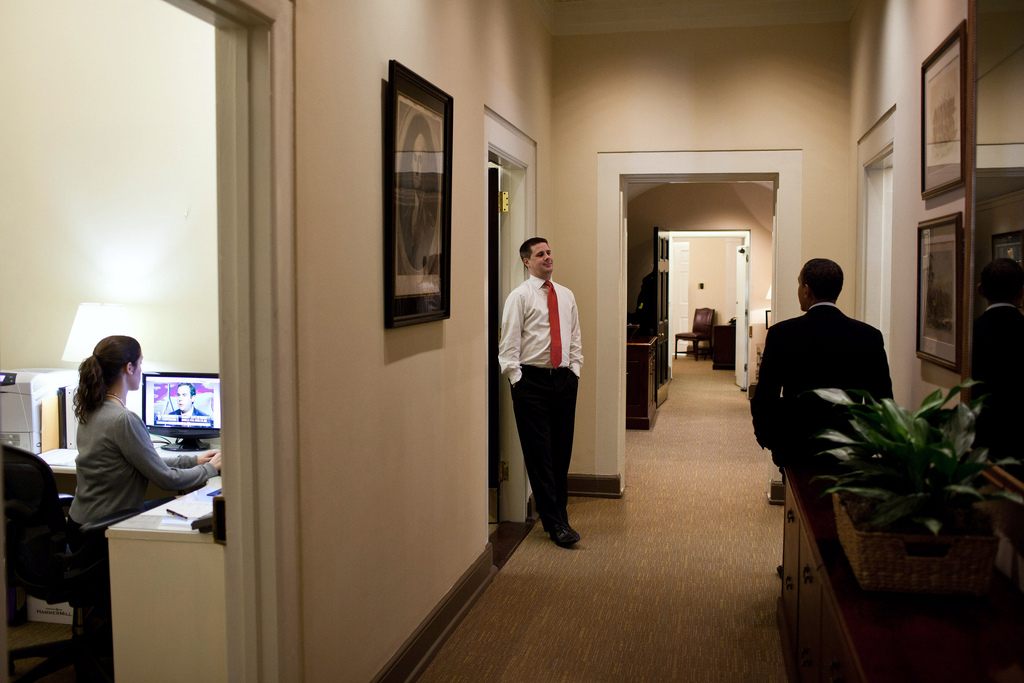A Brief History of the White House, as Portrayed by Hollywood
Independence Day wasn’t the first, of course.

The White House being destroyed by aliens in the 1996 film Independence Day. (Photo: Courtesy 20th Century Fox)
A version of this post originally appeared on Tedium, a twice-weekly newsletter that hunts for the end of the long tail.
It was an explosion that only the aliens saw coming.
Almost exactly 20 years ago, the film Independence Day hit theaters and featured perhaps the single most iconic visual effect of the 1990s—a short, but effective shot of the White House getting destroyed by a gigantic alien mothership.
The scene is memorable for a lot of reasons, one of which is that it looked pretty realistic.
So, in honor of the recently-released Independence Day sequel, we’re talking patriotic film sets. How did they get that set to look so, uh, White House-y? And where did they film all of those exploding White Houses, anyway?
The home of the American president has only, in real life, been destroyed once: by the British of course, during the Burning of Washington in the War of 1812, but that hasn’t stopped Hollywood, of course. Director Roland Emmerich has managed to take it down three times in less than two decades— first in Independence Day, and later repeating the feat in 2009’s 2012 and 2013’s White House Down.
So how do they do it? Herein, a brief history of blowing up the home of the American president.

Let’s start with Emmerich’s first try at turning the White House into a pile of rubble, since of the many controlled explosions of our country’s most famous homestead, this seems to be the one that sticks most with movie viewers.
But for such an impactful explosion, it wasn’t actually all that large in size.
See, Independence Day—released at a point when CGI was in infancy—took the art of model design and put it into overdrive to give the special effects the extra push they needed.
Other parts of the movie went kaboom in miniature as well, but the White House easily had the greatest amount of detail—which is why it’s so memorable. It was a 5-foot-tall 1:24 scale model—a replica that was essentially built to be destroyed. To give you an idea of how small that is, here’s a similarly scaled White House model.
“The White House has got such great detail in it that even in the most preliminary tests that we’ve done, that the White House holds up in extreme close-up,” visual effects director Bob Hurrie noted in a making-of video for Independence Day. “So, all of a sudden, this particular miniature is very near and dear to our hearts because it’s got such wonderful detail. I don’t know if I really wanna blow it up or not!”
The model, built of plaster and molded manually, looks impressively like the real thing despite its small size. But in ways relevant to the filming, that small scale had some key differences that a full-size building wouldn’t—particularly, that it goes ablaze extremely quickly.

The film used a scale model of the White House, like this one at the Nixon Library. (Photo: Jack Miller/CC BY-SA 2.0)
The solution to this issue is a combination of visual trickery and mathematics. The model was shot with nine different cameras at a variety of speeds, at a total speed of 305 frames per second.
As a result, a scene that lasted about eight seconds in the film itself only took about a second to shoot, and was then slowed down to the speed necessary for it to look natural to the human eye.
The finished scene was so realistic that Emmerich had to actually edit the scene slightly so people realized that the president and his family were able to get away from the exploding White House unscathed. Not bad for a building the size of a Barbie dream house.
Of course, Independence Day was but one portrayal of the White House on screen. A few other examples:
To better allow for the walk-and-talks that the show traded in, The West Wing had a single floor with wide hallways, despite the fact that the actual west wing of the White House has two floors.

President Obama in the West Wing of the White House, which was depicted differently in the TV show The West Wing. (Photo: The White House/Public Domain)
Idiocracy’s White House has a memorably white-trashy exterior, with a swimming pool, satellite dish, and tire swing depicted outdoors. The infamous “Brawndo’s got what plants crave” scene also shows a White House conference room with some particularly hilarious renovation work.
If you’re watching the show Scandal expecting an accurate White House display, you might be disappointed. The website Seeing Stars notes that much of the show is shot around the Los Angeles area. Likewise, House of Cards films many of its scenes in Baltimore, a city with architecture that looks enough like D.C. that the crew can kind of pull it off.
In slightly more fantastical turns, the 2012 film Abraham Lincoln Vampire Hunter had no chance of being the most historically accurate film about Abraham Lincoln released in 2012 (look to Lincoln for that), but the film did take care to offer up historical touches to give the film its 19th-century feel. Production designer François Audouy says they shot the White House interior scenes in New Orleans’ former city hall. That’s cool. Not so cool, however, is the film’s use of CGI for the exterior shots.
So yes, that’s a lot of sets. Do they get used in other productions? You betcha.
Jason Winer, director of the single-season NBC family comedy 1600 Penn, noted that the sets used on his show were marked up with identifiers from other productions.
“In fact, our pilot’s Oval Office walls were used on The West Wing, and those on the permanent set were in a Nicolas Cage movie — I know this because I saw the words ‘National Treasure’ written in Sharpie on the back of them,” Winer told The Hollywood Reporter about his show, which featured Josh Gad as the awkward son of the First Family, along with president emeritus Bill Pullman doing the job he was born to do.
1600 Penn isn’t alone: The Oval Office created for the film Dave also showed up in Hot Shots Part Deux and Clear and Present Danger, while the Oval Office created for the Aaron Sorkin-written The American President had a lengthy second life in Sorkin’s The West Wing, along with Nixon and Independence Day.
Now, films aren’t the only place where you’ll find replicas of the White House. In fact, people have been building their own versions of the president’s mancave (and potential ladycave) for years, including a 3/4-size replica that was built by an Iranian immigrant after he moved to Atlanta.
And if you’re not in the United States, no worries, you’re in luck: In China, bold developers have been creating their own White House replicas for years, some costing as much at $10 million. All those set designers seem like they aren’t trying hard enough in that context.
So, note to President Whitmore: If you find your version of the White House suddenly uninhabitable due to aliens, head down to McLean in Virginia. There’s a perfectly serviceable replica there, ready for all your needs.
A version of this post originally appeared on Tedium, a twice-weekly newsletter that hunts for the end of the long tail.










Follow us on Twitter to get the latest on the world's hidden wonders.
Like us on Facebook to get the latest on the world's hidden wonders.
Follow us on Twitter Like us on Facebook